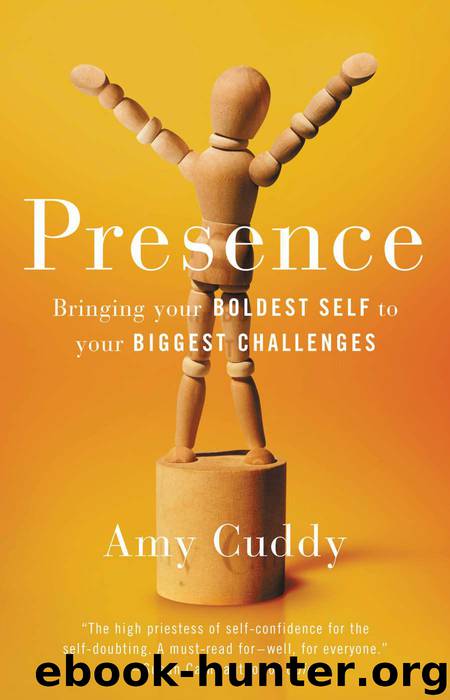Presence: Bringing Your Boldest Self to Your Biggest Challenges by Amy Cuddy

Author:Amy Cuddy
Language: eng
Format: mobi, epub, azw3
Tags: Business &, Nonverbal Communication, Economics / Women In Business, Social Science / Body Language &, Self-Help / General, Economics / Leadership, Psychology / Social Psychology
Publisher: Little, Brown and Company
Published: 2015-12-21T16:00:00+00:00
About Face
If you were going to conduct an experiment to directly test James’s hypothesis that bodily expressions cause emotions, where would you begin? The face seems like a good place to start, but which facial expression? Which emotion? To create a proper test of how the body influences the mind, you’d have to get someone to make a facial expression without associating it with the emotion it connotes. A tricky thing to manage.
In 1974, the psychologist James Laird published the results of a study in which he’d set out to measure whether physically expressive behavior can create emotional experience—or, in English, whether frowning makes us angry and smiling makes us glad.7
Laird knew that telling his subjects the purpose of the experiment might bias their answers, so he constructed a clever ruse to throw them off. First he told the participants (undergraduate men) that the experiment’s aim was only to study “the activity of facial muscles under various conditions.” Then he attached electrodes to various points on their faces and connected them to fancy-looking machinery that in fact did nothing.
In order to arrange an “angry” expression, he would lightly touch the electrodes between their eyebrows and say, “Now I’d like you to contract these muscles.” He’d also touch the electrodes at the corners of the jaw and ask the subjects to contract those, perhaps by clenching their teeth. For a “happy” expression, he asked subjects to contract the muscles at the corners of the mouth.
As subjects held these poses, they were asked to rate their emotions. Laird told them he needed these ratings in order to rule out any error, because sometimes emotions can create unwanted changes in facial muscle activity. Another falsehood to throw them off.
Even after excluding all the subjects who suspected what was up, Laird found that subjects felt angry when holding an angry expression and happy when holding a happy one. One participant even told him: “When my jaw was clenched and my brows down, I tried not to be angry, but it just fit the position. I’m not in an angry mood, but I found my thoughts wandering to things that made me angry, which is sort of silly, I guess. I knew I was in an experiment and knew I had no reason to feel that way, but I just lost control.”
In a famous 1988 paper, Fritz Strack, Leonard Martin, and Sabine Stepper went even further, describing the results of a study that tested what had by then come to be known as the facial feedback hypothesis.8 Without explaining why, they instructed participants to hold a pen in their mouths in a way that engaged the muscles typically associated with smiling. Other randomly selected participants were told to hold a pen in their mouths in a way that inhibited the smile muscles. All participants were then given cartoons to read. People in the smile condition found the cartoons much funnier than the people who were unable to smile. That finding has been replicated in Japan and Ghana9 and extended through the use of different methods and the analysis of different outcomes.
Download
Presence: Bringing Your Boldest Self to Your Biggest Challenges by Amy Cuddy.epub
Presence: Bringing Your Boldest Self to Your Biggest Challenges by Amy Cuddy.azw3
This site does not store any files on its server. We only index and link to content provided by other sites. Please contact the content providers to delete copyright contents if any and email us, we'll remove relevant links or contents immediately.
Hit Refresh by Satya Nadella(8995)
The Compound Effect by Darren Hardy(8735)
Change Your Questions, Change Your Life by Marilee Adams(7566)
Nudge - Improving Decisions about Health, Wealth, and Happiness by Thaler Sunstein(7460)
The Black Swan by Nassim Nicholas Taleb(6948)
Deep Work by Cal Newport(6818)
Daring Greatly by Brene Brown(6369)
Rich Dad Poor Dad by Robert T. Kiyosaki(6318)
Principles: Life and Work by Ray Dalio(6132)
Man-made Catastrophes and Risk Information Concealment by Dmitry Chernov & Didier Sornette(5878)
Playing to Win_ How Strategy Really Works by A.G. Lafley & Roger L. Martin(5774)
Digital Minimalism by Cal Newport;(5588)
Big Magic: Creative Living Beyond Fear by Elizabeth Gilbert(5556)
The Myth of the Strong Leader by Archie Brown(5375)
The Slight Edge by Jeff Olson(5315)
Discipline Equals Freedom by Jocko Willink(5241)
The Motivation Myth by Jeff Haden(5125)
Stone's Rules by Roger Stone(4989)
The Laws of Human Nature by Robert Greene(4926)
